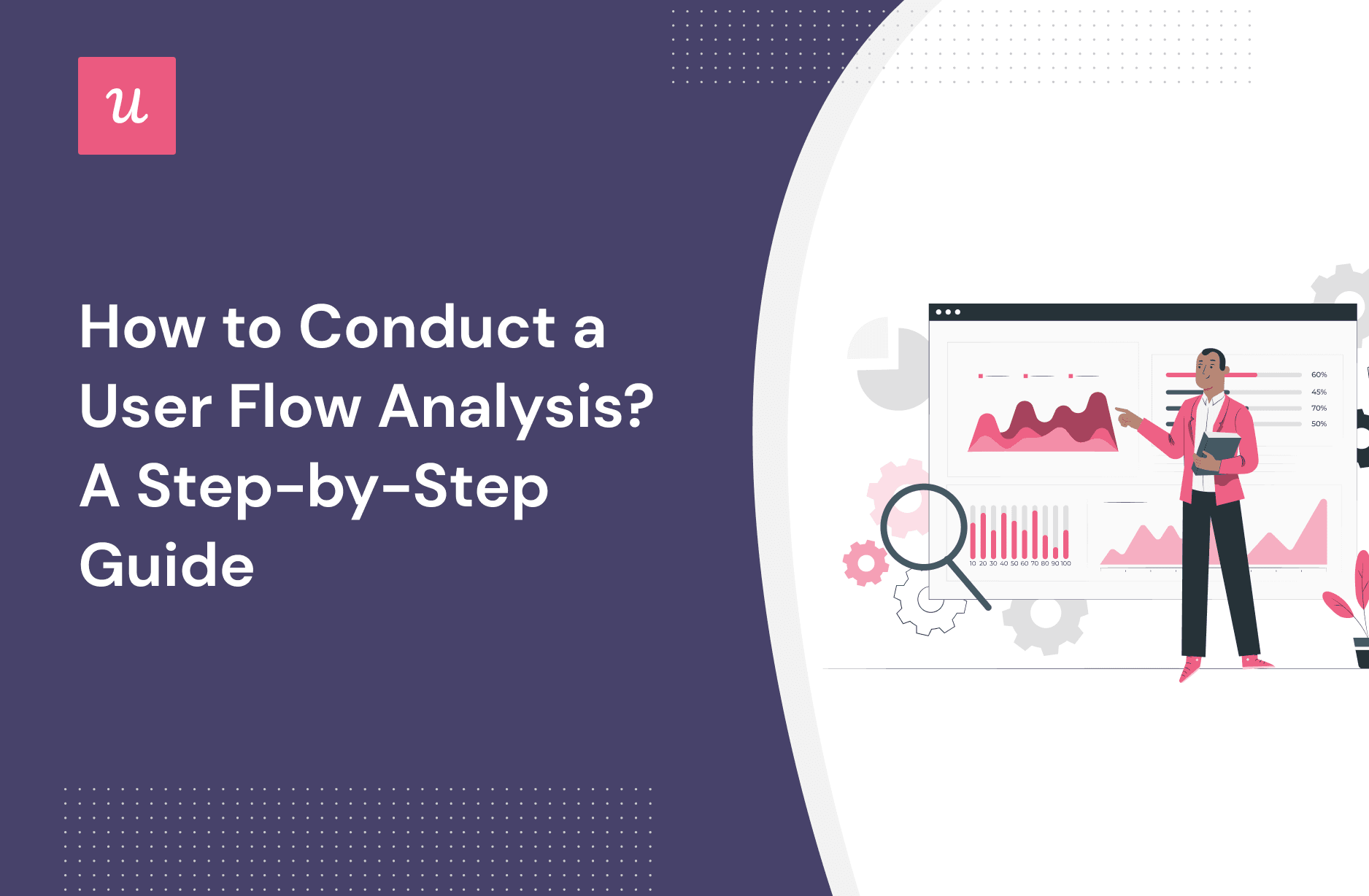
A better understanding of your users is never a bad thing and user flow analysis can be an extremely powerful tool to help you build it.
In this guide, we’re going to break down what a user flow is, explain how to analyze the process, set out how to identify and capitalize on opportunities, and share the tools that’ll help you drive product growth.
Try Userpilot Now
See Why 1,000+ Teams Choose Userpilot

How to conduct user flow analysis – quick summary
- User flows are a detailed visualization of the specific steps in a path or process a user takes to finish a given task. A user journey is a similar visual representation, but they’re usually far broader and encompass an entire experience.
- An example of user flow is a sign-up flow, breaking down the individual steps a user needs to follow to create an account.
- Conducting user flow analysis will help you better understand user behavior, reduce churn, and boost conversions.
- You can use user flow analysis to identify the fastest route to value (the happy path), remove friction wherever your users encounter it, monitor behavior for each segment, and optimize the whole experience.
- To conduct user flow analysis in your own product, there’s a handy framework to work from. Start with a clear goal and define your success metrics, visualize the flow, conduct detailed analysis, use what you’ve learned to prioritize improvements, and continually test and iterate as you go.
- Of course, none of this is possible without the right tool for the job. If you’re a more casual user, a free tool like Google Analytics might be sufficient.
- If you want a granular insight into user flows and behavior, you need Userpilot. Book a demo to see it in action.
What is a user flow?
Recently, “user flows” have become an increasingly popular concept in the SaaS world. You’ll often hear them discussed alongside – or even used interchangeably – with “user journeys”.
- User flows are typically an intricate, detailed graphical representation of the specific steps in a path or process that a user takes to complete a given task (i.e., signing up for an app).
- User journeys are a much broader term, representing a holistic view of the complete customer experience (i.e., initial engagement, onboarding, customer support, and so on – not just a task in your app).
In a nutshell, a user flow is zoomed in – and user journeys are zoomed out.
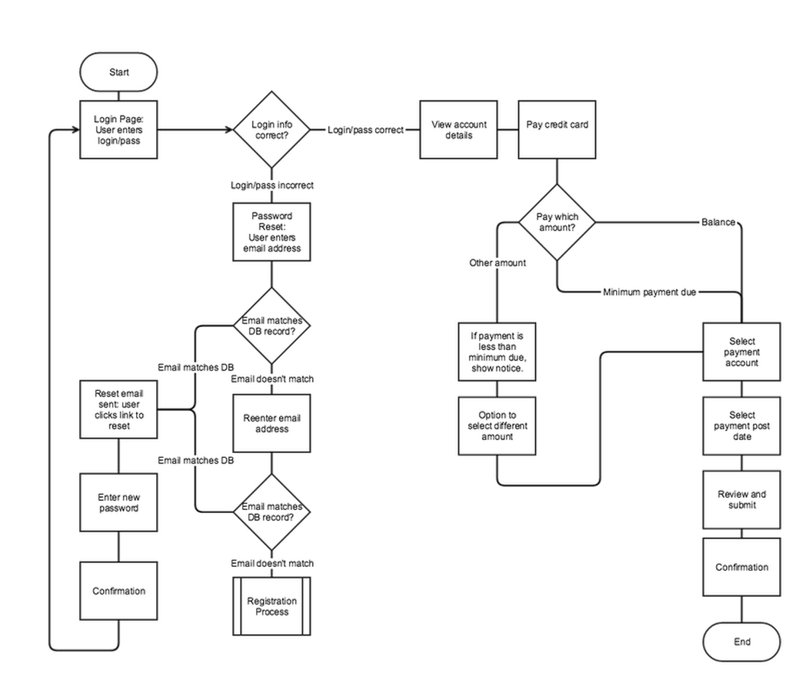
What are some user flow examples?
Here’s an example of what a signup user flow might look like for a SaaS product:
- Users visit the website and land on the signup landing page.
- The users click on the relevant button to create a new account.
- They provide key personal data (i.e., email address, password, and other information regarding which user segment they fit).
- After a user account has successfully been created, they’re asked to verify their email address.
- They are then redirected to your app where they continue account set-up.
- Users save their changes and land back on the home screen – ready to start using your key features!
As you’d imagine, there can be a number of flow types depending on the context.
An onboarding flow might involve a range of UI patterns to help users discover and engage with your product, improving conversions from free to paid users.
On the other hand, a cancellation flow (which is an unfortunate but necessary task) might involve a user triggering a request, speaking to customer support, entering data explaining their cancellation reasons, etc.
What is a user flow analysis?
User flow analysis describes the process of understanding how users interact with a website or app.
It’ll typically involve looking at the various paths toward a goal and figuring out the pain points and areas of friction that contribute to an unhappy path.
User flow analysis and UX analytics are valuable tools for improving the usability of a website or app – more on this below.
Why monitor a users flow report?
There are many reasons to look into a users flow report:
- Understand user behavior. Dig into behavior data, product usage, and the paths customers take through your app. This sort of behavioral analysis will help you build a deeper understanding of the why behind certain decisions.
- Focus on conversions. A user flow report will show you where the important steps in the journey are. By identifying these pivotal points, you can increase the likelihood that users will take the desired action (i.e., signing up for a newsletter or making a purchase). Hence, improving your conversion rates.
- Reduce churn. By identifying (and removing) bottlenecks and areas of friction in the customer journey, you’ll be able to make better decisions on design and user experience. Consequently, creating a happy path for your users.
What can you achieve through analyzing user flows?
So, you’ve decided to take a deeper look into your user flow reports. Let’s explore what your newfound understanding will enable you to do…
Identify the happy path
The happy path describes the fastest possible, error-free path your users can take to achieve the desired result in your product.
Through conducting a user flow analysis, you can identify the ‘ideal’ journey through your product. Once you know the quickest route to value, you can break down the behaviors that get more users there faster. This will help in creating more engaged, loyal users.
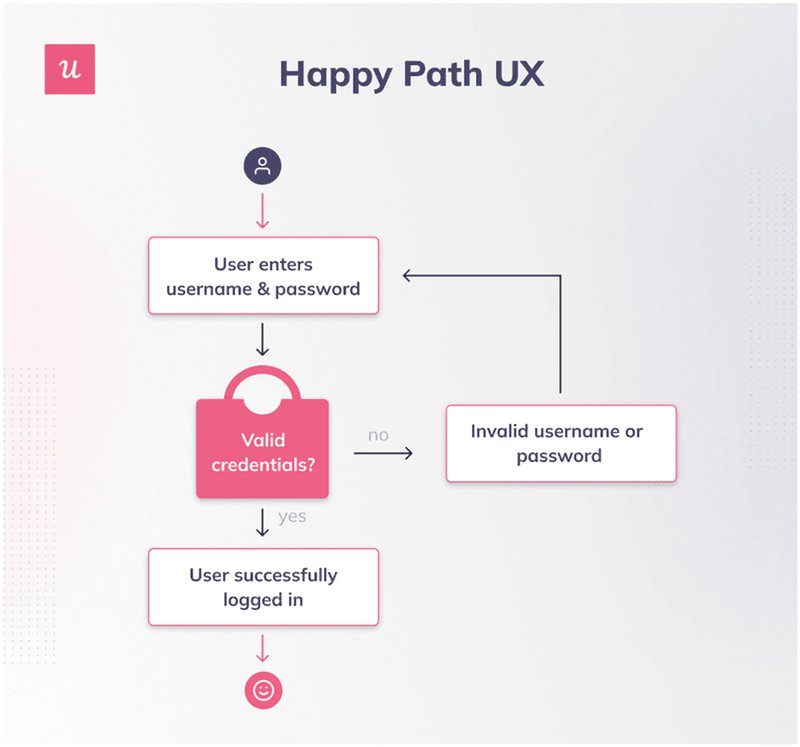
Remove friction from user journeys
Once you zoom out, you’ll build a clear view of all the steps a user takes in your product – including the first step, the dead ends, and of course the areas of friction.
Remember, friction is anything that impedes your users’ flow: it could be a broken bit of your interface, a confusing UI element, or an overwhelming piece of functionality.
Your overall aim should be to deliver a frictionless customer experience.
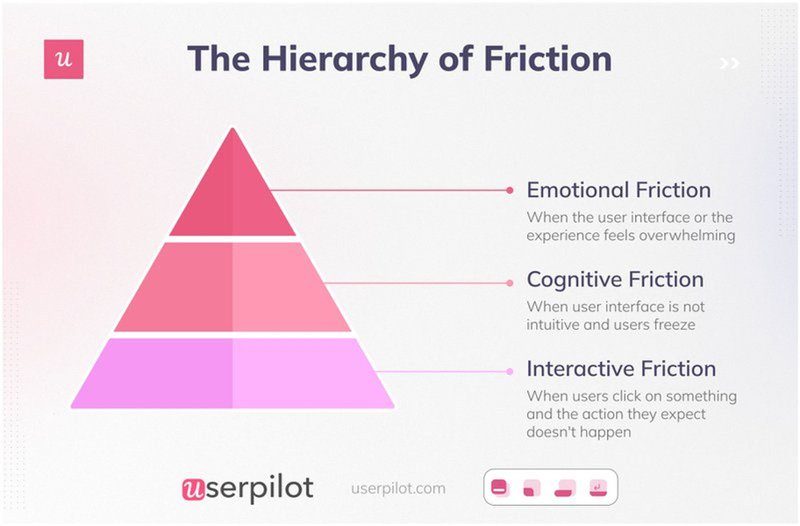
Monitor how different user segments interact in-app
You shouldn’t treat your users like one homogenous group: they’ll have contrasting goals, dissimilar behavior, conduct business differently, and so on.
UX analysis will help you understand the difference between distinct groups. Which particular segments are more likely to complete all the steps in a user flow? Which features are more relevant to one group over the other?
You can then tailor the experiences to optimize the flow for each segment (for example, distinct in-app messaging, custom UI patterns, and more).
Optimize the customer experience
Ultimately, a user flow analysis will help you identify the happy path, remove unnecessary steps and bottlenecks, and create a seamless journey. All of this will lead to a positive customer experience overall.
How to conduct a user flow analysis?
Let’s break down how you would conduct any sort of user flow analysis in your SaaS:
Step 1: Decide your goals and success metrics
First things first, you need to figure out why you want to conduct an analysis in the first place. Do you want to reduce the churn rate, boost activation, increase engagement – or something else?
Once you’ve tied what you’re doing to a product goal, you need to figure out a way of tracking progress. There are a whole host of different metrics to consider using:
- Customer satisfaction (CSAT) score.
- Retention rate.
- Adoption rate (individual feature and entire product).
- Activation.
- Lifetime value (a useful financial metric).
- Conversion rate (specifically from free to paid).
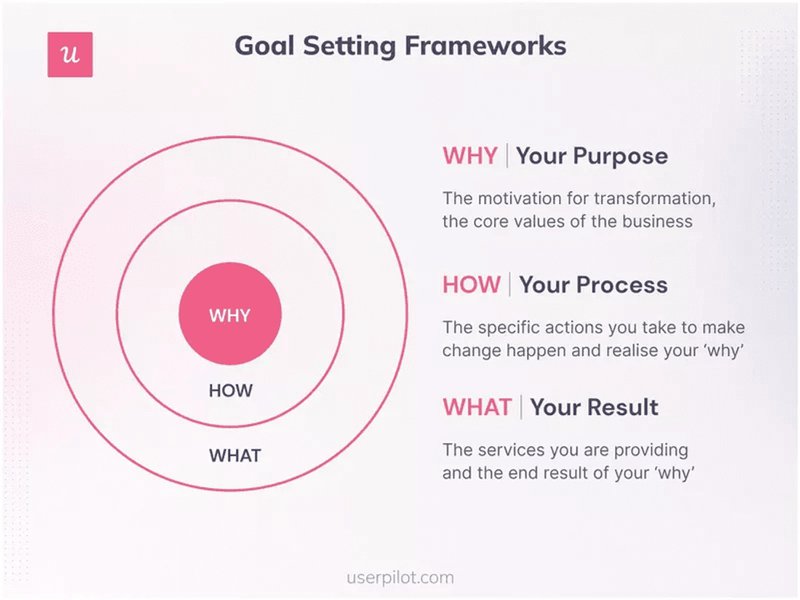
Step 2: Visualize your selected user flow diagram on a product analytics tool
Next up, it’s using the right analytics tool to visualize the customer journey (or user flow) clearly.
Of course, you don’t want to rely on guesswork. Utilize a range of sources to gather quantitative and qualitative data that supports your analysis.
A good user journey map will highlight important touchpoints, help you understand where visitors enter, how often users navigate to a different page, and the final action a user takes in a journey.
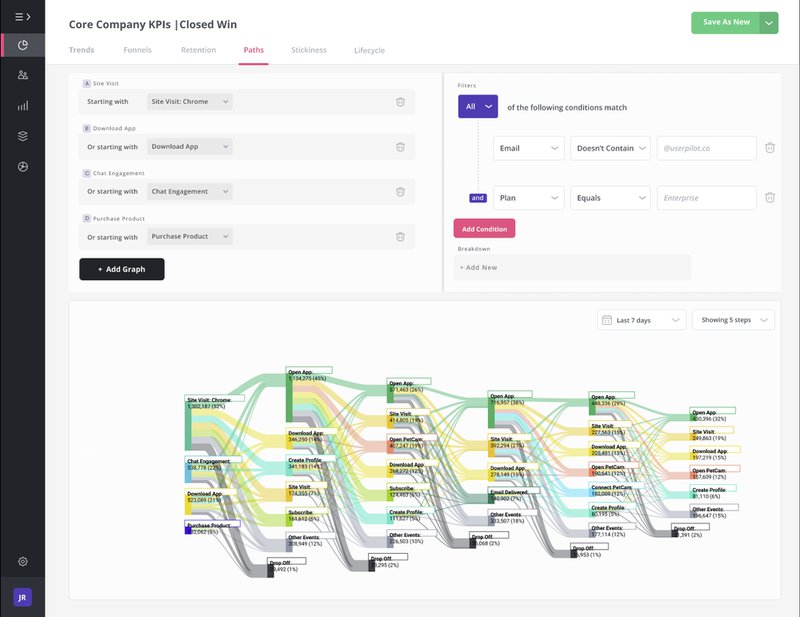
Step 3: Analyze the user flow to understand user behavior
Once you’ve visualized your user flows, you can dive deep into the details of how your users are actually behaving.
For instance, you might want to analyze how different segments complete a specific task, how long they take, and how likely they are to progress to the next step.
Step 4: Prioritize improvements to create a good experience
If there’s one thing user flow analysis can help you with, it’s figuring out where your opportunities for improvement are.
Here’s an example: let’s say your analytics shows a spike of users dropping off at a specific page in the onboarding flow. You could try and improve the UX on that screen (i.e., with contextually relevant tooltips – or another form of in-app messaging – to help them understand your tool).
Repeat that throughout your app, and you’ll see significant improvements to your product.
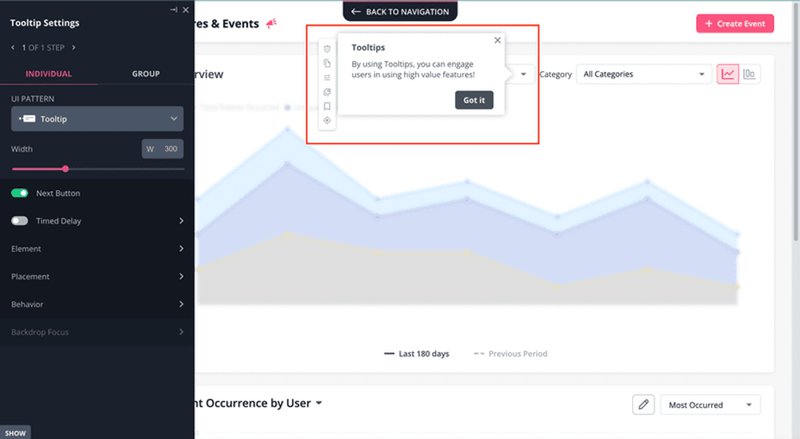
Step 5: Continuously test and iterate on your user flows
User flow analysis isn’t a once-and-done activity.
To get the most value from this exercise, you should start testing early, continually analyze what you’re finding out, and iterate your way to success.
That’ll help you identify patterns and themes in user behavior (including for different segments – remember a new user and a returning user will have vastly different experiences).
Ultimately, you want your conversions to continually improve. A/B testing is a fantastic way of proving or disproving hypotheses that contribute to greater conversions.
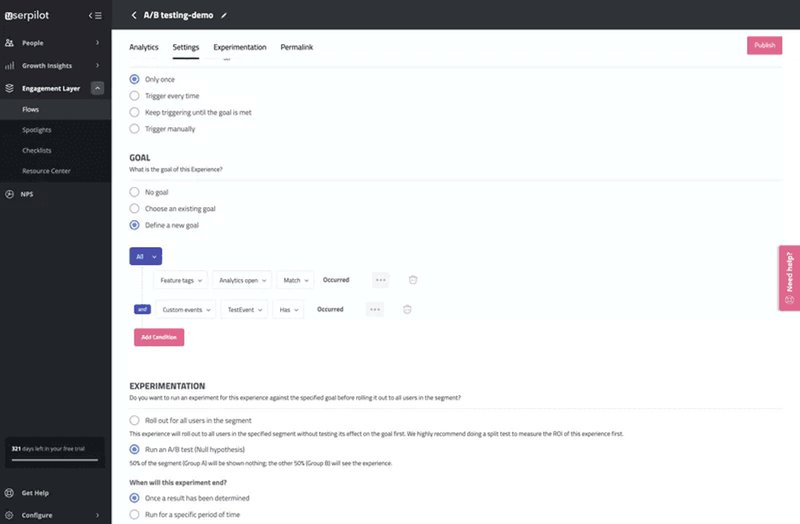
The best tools for performing user flow analysis
User flow analysis simply isn’t possible without the right tool for the job. We’re going to explore a couple of the best universal analytics tools available on the market.
Userpilot – All-in-one analytics and engagement platform
Userpilot is a powerful product growth tool, built with the aim of helping you transform the customer experience and enable your users to achieve their goals.
As an all-in-one platform, it offers several key features:
- Advanced analytics. Powerful in-app analytics help you identify themes and patterns in user behavior and make more informed product decisions.
- Segmentation and personalization. You can identify distinct groups of users and personalize the experiences to best meet their needs.
- Flexible UI patterns. Slideouts, modals, tooltips, and a whole host of other customizable UI patterns enable you to craft an engaging and contextually relevant experience.
- Mobile SDK. Create targeted onboarding flows using slideouts, carousels, and push notifications without writing extra code.
- Integrations. You can also integrate Userpilot with other tools and leverage your existing tech stack.
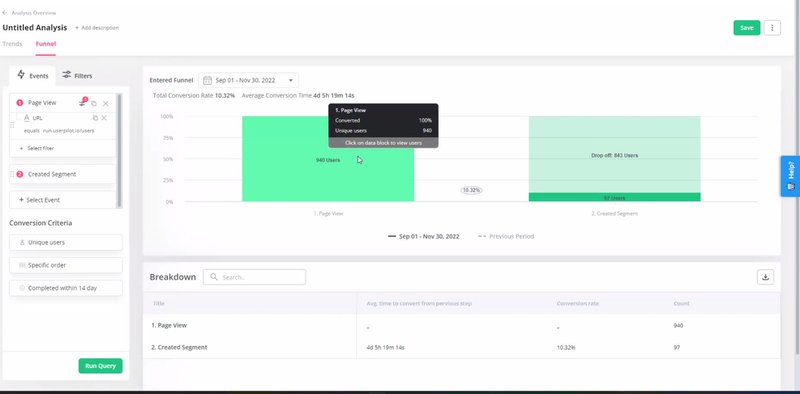
Pricing is linked with user volumes, but there are three broad tiers on offer: Starter, Growth, and Enterprise.
Starter is an entry-level plan starting at $299 a month (paid annually) for up to 2000 monthly active users. It includes features for in-app engagement, basic flow analytics, and NPS surveys. Growth, the most popular plan, has custom pricing and comes with advanced analytics, surveys, and session replays. Enterprise has custom pricing based on user needs.
Google Analytics – Free tool for analyzing user flows
Google Analytics is a free, accessible web analytics tool that gives you a decent level of insight into how your web pages are performing. The new Google Analytics 4 can also track in-app events for you.
Key features include helpful data on user sessions, segment-level analysis, insight into how users navigate between pages, and even how long they spend on each screen.
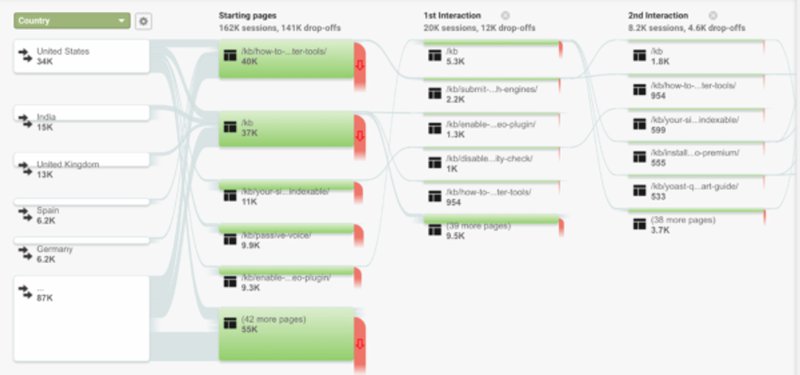
For a free tool, it’s surprisingly powerful: anyone with a Google Analytics account can view a user flow report and visualize how visitors are progressing through your website or app.
Conclusion
You should now have all the resources you need to conduct a user flow analysis in your product and use what you learn to optimize elements of your interface for your audience.
If you want to get started with user flow analysis, get a Userpilot Demo and see how you can dive deep into user behavior and make more informed product decisions today.







